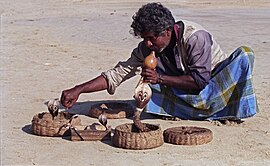Sri Lankan Gypsy people

Sri Lankan Gypsy Snake Charmer
|
|
| Regions with significant populations | |
|---|---|
|
|
|
| Languages | |
| Sri Lankan Gypsy Telugu , Sinhala, Tamil | |
| Religion | |
| Animism, Buddhism, Hindu, Christianity | |
| Related ethnic groups | |
| Sinhalese, Sri Lankan Tamils |
Sri Lankan Gypsy people are an ethnic group from Sri Lanka who trace their origins in India (Telugu areas of Madras Presidency) centuries ago. They are the only nomadic group of people living in Ceylon and are known as the Ahikuntakas otherwise called Kuravans. They live in small palmyra huts for two or three days in one place Wijesekera, Nandadeva (1965). The people of Ceylon. M.D. Gunasena. p. 53.. They mostly speak Telugu, also known as Sri Lankan Gypsy Telugu, a Dravidian language natively spoken in India. Various governments, NGOs and missionary societies have made attempts to settle them down, and thus some are settled in villages. Amongst the majority Sinhalese speakers they are known as ahikuntaka, while amongst the minority Sri Lankan Tamils and Muslims they are known as Kuravar. Some make their living by fortune telling, snake charming and using monkeys and dogs in performances. Those who are settled in resettlement villages are subsistence farmers and farm hands to other farmers. They also speak Sinhalese or Tamil based on their area of settlement. Most seem to be settled in the eastern Batticaloa district. Most follow rudimentary elements of Hinduism, while some are Christians and yet others adhere to Buddhism.
...
Wikipedia
